
Ah, who can resist the ambiance of a crackling fire! Well, it turns out quite a few can. Whether to use a fireplace or not is a controversial topic in building science. The main problem is that a typical wood-burning fireplace actually has a net cooling effect on a home. (And that applies also to when they’re not in use if the damper stays open.) Then there’s the effect they have on indoor air quality.
So, is having a fireplace worth it? This past winter I used my fireplace (photo above) for the first time, and that got me thinking. I also had a lively discussion on LinkedIn about this topic, but let’s expand it here now.
Why have an indoor fire?
There are two main reasons people have fires indoors. One is to get the ambiance of that crackling fire. And the other is to heat the home. I’m going to focus on heating in this article, but keep reading even if you’re just an ambiance burner. I’ll discuss some issues below that might help you get the ambiance you want without the negative consequences.
Now, let’s discuss using a fireplace to heat your home. For some people, it’s the primary source of heat. For most, it’s supplemental. I’m in the latter category, or at least I will be when I’m done. The reason is that I want another source of heat to supplement my undersized heat pumps when it’s really cold or to provide emergency heat when the power goes out.
I have two Mitsubishi heat pumps heating my house, and neither of them has a backup heating system (called auxiliary heat when installed in the heating system). When an arctic blast came through Atlanta in December 2022, our heat pumps couldn’t quite keep up. Our indoor temperature went as low as 63 °F (17 °C).
Indoor temperature
Now, the Montanans, Vermonters, and Canadians are saying, hey, what’s the problem with that temperature? But not everyone wants such a low temperature in their homes. In fact, the Air Conditioning Contractors of America (ACCA) specify 70 °F (21 °C) as the indoor design temperature, and that feels pretty good to me.
But of course, there’s another aspect of fireplace building science I should mention here. My friend Robert Bean is always quick to point out that thermal comfort is about more than air temperature. When you’re in a building with a tight building enclosure—one that’s well air-sealed and insulated, and has good windows—you can be comfortable with air temperatures well below the recommended design temperature.
I know it’s true because I built a house with a good enclosure and was able to keep the thermostat at about 64 °F (18 °C) and be perfectly comfortable. It’s all about the mean radiant temperature.
Where does the air come from?
Now, back to fireplaces. When you start a fire, the combustion process pulls oxygen from the air. The bigger the fire, the more air it takes. And then the exhaust gases go up the chimney and leave the house. But one of the primary rules of air leakage is that when a cubic foot of air leaves the house, another cubic foot has to come in. Fireplace, meet some basic building science here.
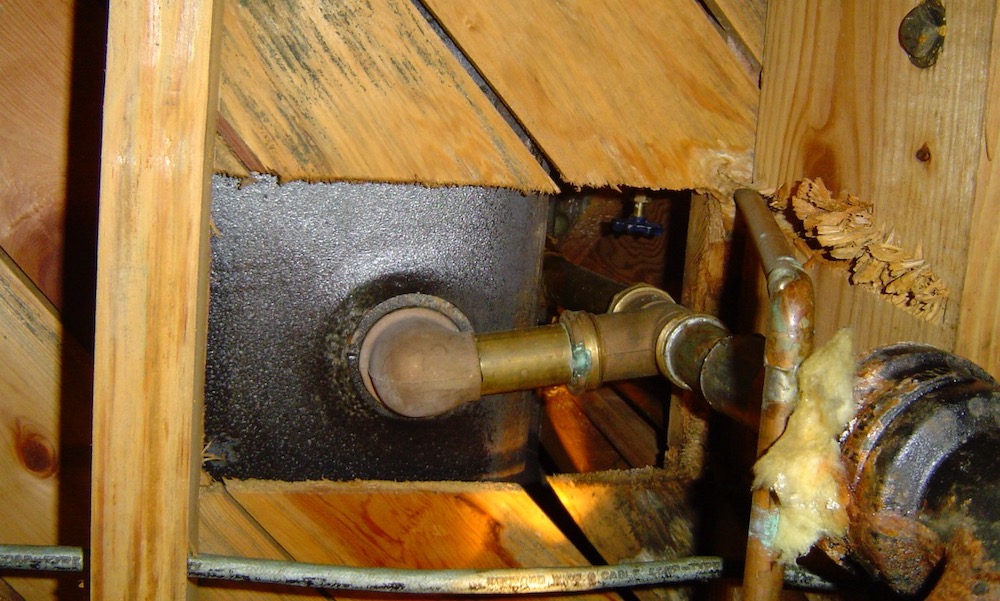
For the typical fireplace, that makeup air comes in through random leaks in the building enclosure. The photo above shows a big hole where the bathtub drain goes through the floor. As long as the fire is going, it’s pulling in air through these random leaks.
And here’s the thing: The air going up the chimney can include a lot more than just the combustion gases. As the chimney warms up, it creates a draft that can pull in even more air from the house due to the stack effect. The result often is a net loss of heat from the house. I think that’s what happened at my house when I made the fire this past weekend. And that was even with the glass doors closed.
Combustion in airtight homes
In an airtight home, it may be difficult to get a fire started or keep it going. If you want a fireplace in that type of house, you should do one or both of these two things: 1. Provide combustion air in the fireplace, and/or 2. Use a more efficient way of burning wood. The latter is most important.
Ducting air near the fireplace may or may not help much. You can draw all the arrows you want showing air coming in those ducts, but air follows the pathways of least resistance. Instead, by putting the combustion air directly into the fireplace, the fire will use less heated air from the home.
Even then, though, much of the heat from the fire may still escape up or out the sides of the chimney. And that’s why you want to burn the wood as efficiently as you can. Let’s start with the chimney.
Where is the chimney?
Chimneys come in many designs, but there are really only two types that matter for efficiency. Some chimneys are outside the house (photo below). When it’s cold outdoors, all that mass in the chimney is cold. That means is takes longer to heat up when you start a fire. It also means the chimney loses heat directly to the outdoors once it does heat up.
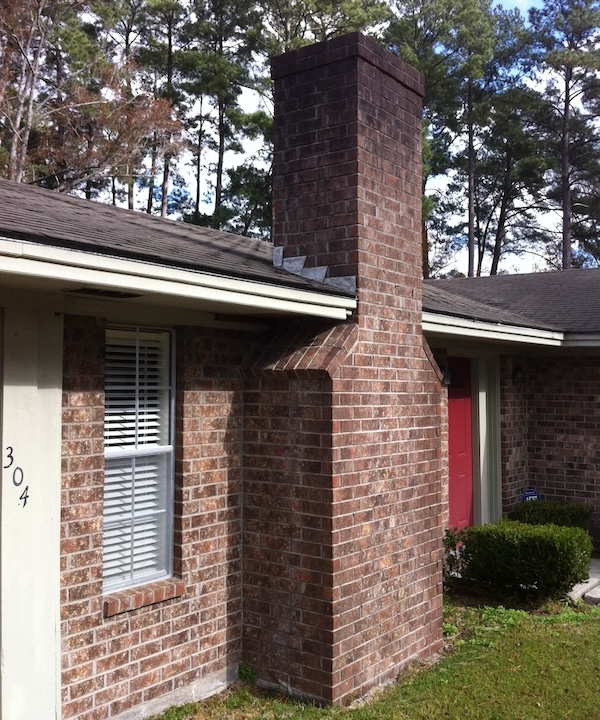
The more efficient style is the chimney that goes up through the house, as seen in the photo below. Except for the part that’s outside the building enclosure, the mass of the chimney is at about the same temperature as the indoors. In my case, the attic is conditioned so it’s only the part of the chimney above the roof that’s really cold.
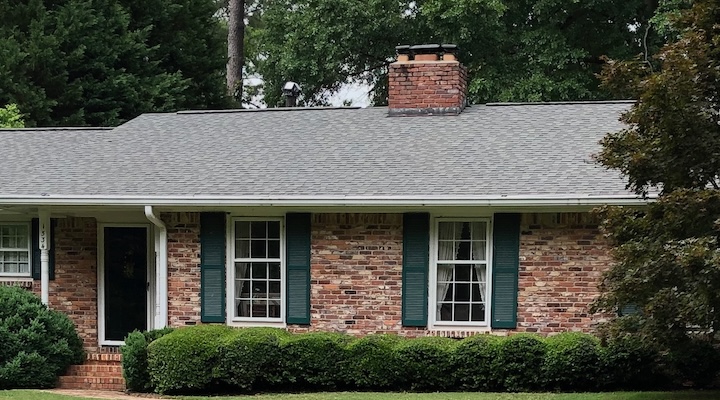
Outdoor temperature
The outdoor temperature matters for a couple reasons. First, the colder it is outdoors, the colder the makeup air for combustion will be. If that makeup air is going into the living space, it can create comfort problems. It also makes it harder for the fireplace to heat the house.
Second, if the chimney is on the outside, it’ll take longer to heat up and draft properly. That could put more pollutants in your indoor air.
Fireplace vs. woodstove
I had a woodstove in the house I built, and I loved it. It was a Vermont Castings model with a catalytic converter, and it could heat the whole house without much difficulty. That’s it in the photo below. It didn’t have combustion air ducted into it, and that wasn’t a problem even in my airtight house.
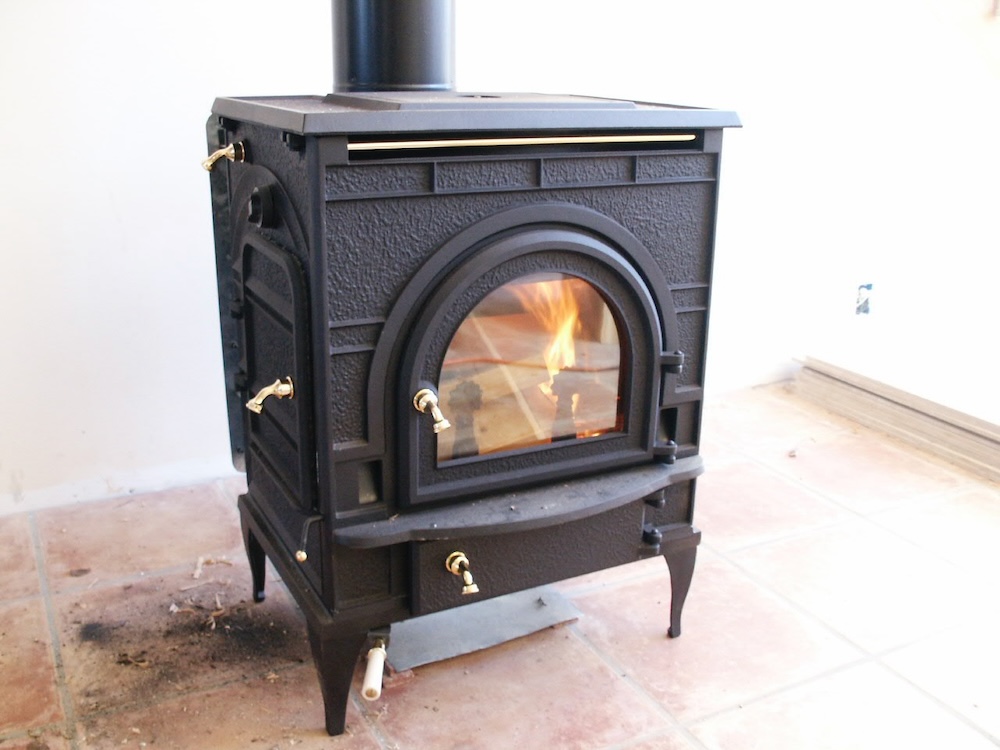
When I’d start a fire, I’d have to crack open a window but only until the woodstove got up to temperature. Once I switched to the catalytic converter, it used only a tiny amount of combustion air and I could close the window. I’ve read that efficient woodstoves might draw only about 15 cubic feet per minute (cfm), which isn’t a problem even in most airtight homes.
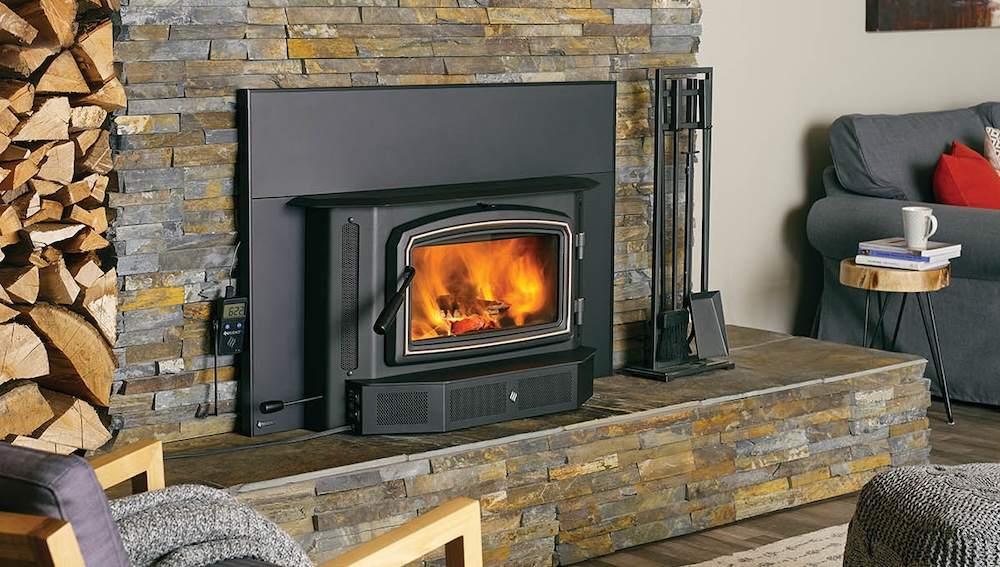
Now I live in an older home (1961) and am planning to install a woodstove in my fireplace for supplemental and emergency heat. A lot of companies make woodstove inserts that go into a fireplace. They burn wood efficiently and with only a little combustion air. Many (most?) have fans to blow warm air into the living space, too.
In my LinkedIn discussion on this topic, a lot of people gave recommendations for woodstove inserts, so check that out if you’re looking to do this.
Gas log fireplace
This article is about wood-burning fireplaces and woodstoves, but let me mention gas here briefly. They definitely beat wood-burning fireplaces in the convenience category since all you have to do is turn them on. The things I discussed above apply to gas fireplaces as well.
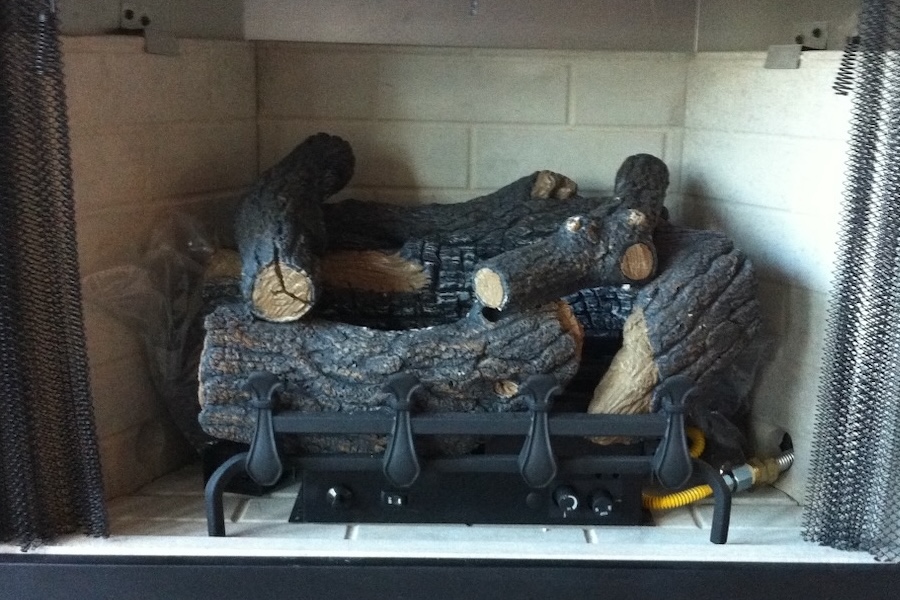
But one big difference is that, incredibly, it’s still legal in many places to use an unvented gas log fireplace. That means ALL of the combustion products go into the living space. Yeah, all the heat stays indoors, too, but that’s not as good as you might think. They also dump lots of water vapor, oxides of nitrogen, and potentially other pollutants into your indoor air. For that reason, some people call them lung-vented fireplaces.
You can read more about the battle over unvented gas fireplaces that’s been going for a decade on the ASHRAE residential ventilation committee. If you really want a gas fireplace, though, get a direct vent model. It exhausts the combustion products outdoors and brings in its own combustion air.
Effect on indoor air quality
OK, let’s wrap this up with a quick look at indoor air quality (IAQ). Burning wood produces a number of pollutants that can get into the indoor air. The primary one to worry about is particulate matter that’s 2.5 microns or smaller, called PM2.5.
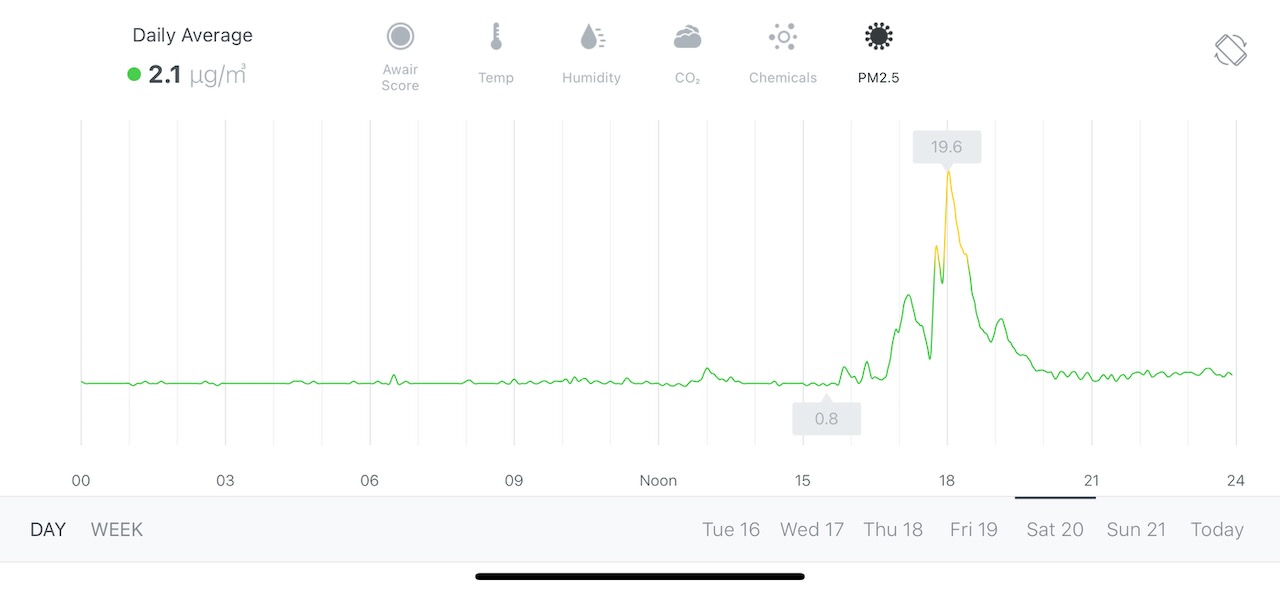
When I made the fire in my house, I watched the PM2.5 readings on my Awair Element IAQ monitor. The time period when the fire was going is easy to spot in the graph above. The four identifiable spikes in the elevated region are probably times when I opened the doors to add wood or move things around.
Overall, though, the PM2.5 stayed fairly low and came down quickly when it spiked. With a woodstove insert, I think it’ll stay in the green almost the whole time.
The nitty gritty
Fireplace building science doesn’t get discussed much. I think part of that is due to a lot of building science folks not having or using fireplaces, especially the kind that sucks a lot of air and heat out of the house. (Ethanol fireplaces are somewhat popular with the passive house crowd, but that’s a topic for another day.) But with efficient combustion and a source of combustion air, they’re not a big thermal or IAQ liability, especially if the chimney goes up through the house instead of the outside.
Do you use a fireplace or woodstove? What’s your experience with burning wood in airtight homes? Leave a comment below.
________________________________________________________________________
Allison A. Bailes III, PhD is a speaker, writer, building science consultant, and the founder of Energy Vanguard in Decatur, Georgia. He has a doctorate in physics and is the author of a bestselling book on building science. He also writes the Energy Vanguard Blog. For more updates, you can subscribe to Energy Vanguard’s weekly newsletter and follow him on LinkedIn. Photos courtesy of author, except where noted.
Weekly Newsletter
Get building science and energy efficiency advice, plus special offers, in your inbox.















15 Comments
Thanks for the article.
Some thoughts and questions -
I understand there are fireplace designs that include a pipe or duct that brings outside air directly into the firebox. Of course, that wouldn't work if the fireplace was open. But assuming it has reasonably well sealed glass doors, would that avoid the problem of interior, conditioned air going up the chimney? Would it be more efficient?
I hear people glow about Rumford fireplace designs, saying that they seem to radiate heat into the space more effectively. Is there anything to that?
And what about the massive Scandinavian and Russian designs that consist of a closed box and a convoluted flue that is supposed to extract more heat into the fireplace mass? It seems to me the more heat that is extracted the less draft there will be. Is that a problem?
I have a small gas log fireplace in my home now. I use it from time to time during the dead of winter for a bit of ambiance, but it also does seem to heat the room up very quickly. I'll be building a new house in the next few years and plan to install another. Partly I like having a natural gas backup in case I have an electrical outage during the winter time. That's often when they happen around here.
great post!
Great article, Allison. Big fan in northwest Wisconsin here of fireplaces for both ambiance and supplemental heating.
We have an air-tight, EPA approved, zero clearance fireplace that's really as much woodstove as fireplace.
The fireplace uses a 4" insulated duct to draw outside air directly into the firebox, but I generally leave the door open slightly when first lighting it for the extra air to get the fire started.
Biggest downsides are cutting and splitting wood, and that can also be an upside, and that I tend to over-build early fires in the fall and about cook us out of the house.
Excellent article, as always, Allison. I always steer my clients away from burning wood, indoors or out, but I live in Maine--the most heavily forested state in the US--and burning wood is deep in our DNA.
If clients insist on burning wood, sometimes I have been effective at convincing them to place the appliance in a 3-season room, where it's less of a health or energy concern. When placed in the conditioned space, I always recommend makeup air of some sort, preferably one made for that particular appliance. And I always warn clients that they will likely have to open a window until the unit gets up to temperature.
Once I learned, several years ago, how little air an airtight stove draws once up to temperature, roughly 1/10 that of an exhausting dryer or a typical range hood on low speed, I stopped worrying so much about that. I do insist that clients buy an appliance that at least meets current EPA standards for PM2.5 emissions, currently 2.0 grams/hr, but encourage lower-emissions stoves, such as mine which is rated for 0.9 grams/hr. There is some controversy over testing protocols but that's another matter.
Michael,
"Once I learned, several years ago, how little air an airtight stove draws once up to temperature, roughly 1/10 that of an exhausting dryer or a typical range hood on low speed, I stopped worrying so much about that."
That's a good point. It's more important to provide make-up air for whatever other appliances (dryers, fans) would cause back-drafting, than for the wood stove itself.
We live on the road which experiences the most power outages in the province, so our wood stove is also a necessary back up for our electrically heated house.
We also use it to provide roughly 50% of out heat, the rest being electric resistance baseboards. If we had to buy firewood, the cost of each source would be a wash. I cut my own wood, so there is some savings, and there would be more if we used the stove more often.
I think we are well past the point where it makes sense to have combustion appliances in urban environments. In rural areas like we live it is a bit more nuanced. The smoke does not affect neighbours, and the firewood comes from nearby logging clear-cuts where it would otherwise be piled up and burned.
As people age, or new owners move in, many houses here are substituting a ductless heat pump for their wood stoves, while keeping the electric baseboards for supplemental heat. That combination seems to work well, but means you do have to find another source of backup for outages.
I agree about combustion appliances in urban environments, and even low-emission wood-burners are not good for the environment. Our goal is to reduce wood stove use and replace our oil-burning furnace with a heat pump system, but we still have building envelope improvements to make first. Electric resistance is pretty expensive here, around $0.22/kWh, so for clients I generally save that for supplementary heat in bedrooms and bathrooms.
Thanks to GBA we came to our senses and deleted the masonry heater from our design during framing last winter. After so many hours researching the double bell chamber design, the obscure Russian “free gas movement” and this different type of combustion, it was a hard goodbye. Burning wood in a higher performance well insulated home did not make sense to us once we realized the design was all wrong and it would totally overheat the main floor after various experts on this site weighed in.
Like anything so much of this is about educating clients in a respectful way that can put the information into the context of their goals and values.
We have many acres of forest and we were really looking forward to the “chop wood, carry water” lifestyle so it was hard to let go of the idea of wood heat. I think we will enjoy chopping a tiny bit of firewood for the BBQ far more than the serious work that is processing enough wood each year to actually stay warm for an entire Canadian winter.
I’m currently building a fairly tight house in rural Washington and have opted to get a Stuv brand wood stove. These stoves have fresh air intakes and their design separates the air that feeds the fire from the air that is warmed (and moved by convection). Pairing this with an ICC Excel insulated chase support has allowed us to effectively air seal and insulate the chimney roof penetration. We’re still mid-construction but are hoping this provides emergency heat for when the power goes out (and it always goes out). Agree that in urban and suburban areas we should eliminate burning wood, but in the middle of the woods that’s a harder sell.
montlamothe,
They look very nice. Which model are you putting in?
It’s the Stuv 16-68 Cube. It’s one size up from their smallest stove.
montlamothe,
Huge area of glass to see the fire!
For the entire winter season last year I heated my poorly insulated 1927 craftsman bungalow with just a single wood stove insert, which I installed brand new in an old fireplace. That wasn't actually my original plan, but it ended up working out just fine. We removed the asbestos-lined pipes from the boiler (for cast iron radiators) in the basement, and we meant to put in new pipes, but we had to do some structural work, and it didn't make sense to re-plumb and then undo it later for the structural work, and then redo it, so we left the house with no heating other than the wood stove, at least for that one season.
The air quality was fine. I know because I have several air quality measuring devices in the house. The heat was more than sufficient. It was inconvenient having to keep the fire going every morning and evening, I admit, but the fire kept things cozy.
The structural work is still on hold for various reasons, so I'm heading into this winter with only the wood stove again. The eventual plan is to fully insulate the house and hook up radiant heating and cooling. But I'll keep the wood stove even after the radiant system is in place. There really is nothing that compares to a live fire.
What state/climate zone do u live in, how many sq ft is your house?
Good questions. I'm in climate zone 4a. My house is about 1600 square feet: 2 stories plus an unfinished basement. It's also relevant that the house was originally designed to be heated by the fireplace. The air flows freely upstairs. The wood stove is in the southwest corner of the house. The stairs are in the southeast corner. The north bedroom upstairs and the northeast corner downstairs don't receive as much heat as the rest of the house, but with the fan on the wood stove to help with convective air currents, every part of the house is warm enough.
Paul,
We are also in climate zone 4. Even though we have a very small wood stove, and our 1200sf isn't particularly well air-sealed or insulated, we have to be careful not to cook the place out.
Log in or create an account to post a comment.
Sign up Log in